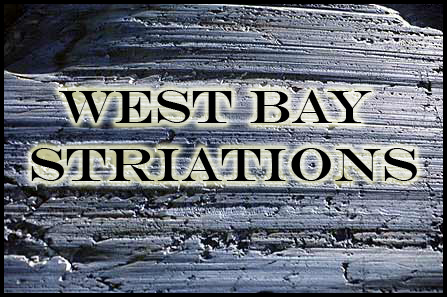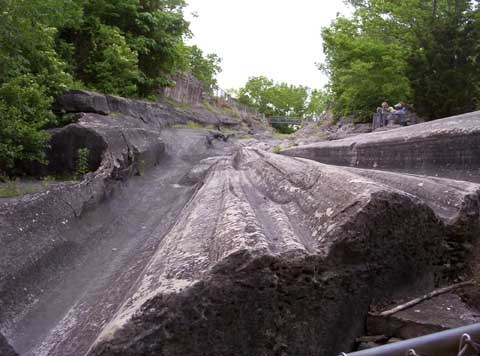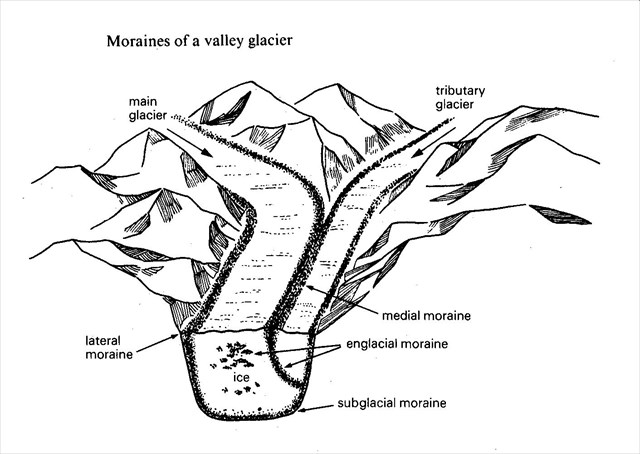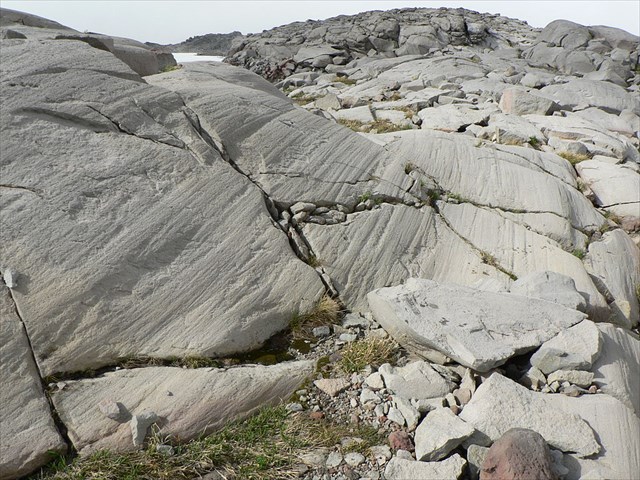West Bay Striations EarthCache
-
Difficulty:
-

-
Terrain:
-

Size:  (other)
(other)
Please note Use of geocaching.com services is subject to the terms and conditions
in our disclaimer.

PLEASE NOTE THAT EVEN THOUGH THIS IS A PUBLIC WALKWAY, DO NOT CLIMB OVER THE RAILING TO REACH THE ROCK WITH OUR SPECIMEN ON IT. THE RAILING IS THERE FOR YOUR SAFTEY AND YOU CAN MAKE ALL OBSERVATIONS EASILY FROM GZ. HOWEVER IF THE TIDE IS OUT, THERE ARE STAIRS DOWN OVER BY THE GAZEBO TO WALK ON THE LOW TIDE BEACH OVER TO THE ROCK FOR CLOSE UP OBSERVATIONS.

Today let us talk about glacial striation, a phenomena that can be observed in many places here in Victoria and throughout the world. The visible evidence that is labeled as glacial striation are scratches and gouges/grooves left in the bedrock caused by the sheets of ice three‐quarters of a mile deep that scoured and shaped our beautiful home of Vancouver Island and Victoria roughly 15,000 years ago.
You have to appreciate the forces that created the glaciers. The cold air just getting colder, snow falling and never fully melting in the summer, and then more snow piling up on top of the old snow and eventually over time this repeating process compacting the snow into sheets of ice. This eventually became the glaciers, and these glaciers moved and slid across the rocks scouring away the hills and mountains we know from the monstrous peaks they once were into the slopes and hills we see them as today.
 Ice itself is not powerful or hard enough to change the shape of rock, so it needs some sort of medium to do the job for it. For this to happen the ice needs to pick up material as it moved across the surface, so debris of all sizes (some being boulders as large as several hundred feet) was picked up from the surrounding bedrock by the glaciers and held in the ice as it moved along. Often material falling onto the surface (the result of freeze-thaw activity, or frost shattering, on the surrounding rock walls) is also transported, and often finds its way down through crevasses to the base of the glacier. While trapped in the ice this debris is known as “morain”, and it is what lends the glacier its power in glacial abrasion. See the included image to the right to see the different types of moraine there are at different levels of a glacier.
Ice itself is not powerful or hard enough to change the shape of rock, so it needs some sort of medium to do the job for it. For this to happen the ice needs to pick up material as it moved across the surface, so debris of all sizes (some being boulders as large as several hundred feet) was picked up from the surrounding bedrock by the glaciers and held in the ice as it moved along. Often material falling onto the surface (the result of freeze-thaw activity, or frost shattering, on the surrounding rock walls) is also transported, and often finds its way down through crevasses to the base of the glacier. While trapped in the ice this debris is known as “morain”, and it is what lends the glacier its power in glacial abrasion. See the included image to the right to see the different types of moraine there are at different levels of a glacier.

Something to take note of is that glacial striation is usually characterized by multiple straight and narrow scratches or deep pronounced gouges/grooves in the bedrock, this representing movement of the glacier and how the trapped debris was used to as “cutting tools”. Also it should be noted that smaller finer sediments "rock flour" scoured and polished the bedrock surface, forming a glacial pavement.
There are a few factors that lend to whether or not glacial striations occur, and how deep they can form in the bedrock via glacial abrasion.
- The amount of rock debris in the basal surface of the ice. If there is no rock in the basal surface of the ice there will be no abrasion, but if there is too much rock in the basal surface of the ice the motion of the glacier will be affected, thusly affecting abrasion rates.
- As the bedrock is being worn away the abrading fragments within the glacier are also being worn. Similarly to sandpaper being worn away with use. A continued supply of abrading fragments is required to uphold a similar level of abrasion.
- The fragments must be harder than the bedrock.
- A constant flow of melt water between the basal surface and the bedrock speeds abrasion. The meltwater constantly rinses away the rock flour allowing the coarser fragments to abrade bedrock.
- Speed of the glacier. The faster the glacier moves, the faster the bedrock will be eroded.
- Thickness of the ice. Thicker ice is heavier ice which causes more downward force and increased pressure between the abrading fragments and the bedrock. There is a limit to how much ice will enhance abrasion. If the friction force between fragments and bedrock is too great the ice will flow around the fragments.
- Basal meltwater under high pressure. If the meltwater is under sufficiently high pressure it will cause the ice to effectively buoy up and decrease the normal force of the ice on the bedrock. Another result of this is that the velocity of the glacier is increased.
- Shape of the fragments. Larger more angular fragments will scratch and scour more effectively than small and round fragments will.
When you reach GZ there is a rock protruding from the water. On this rock are 3 beautiful examples of striae/gouges. This is what you want to be looking at.
To log this cache email me via my profile on geocaching.com the answers to these questions:
1) Using your best judgment, how wide and how deep are the visible striations/grooves on the bedrock here?
2) Using your judgment in observing the striations, what direction do you think the glacier was headed (Hint: use your GPS compass to find the direction)?
Optional bonus activities:
3) Post in your log a photo of you, your GPS, or your group anywhere along the walkway near the striation specimen. Do not include the specimen in your photos!
4) You will notice I also provided an additional Reference Point in the "Additional Waypoints" where another example of glacial striation. It's actually harder to tell what you are looking at because of it's size, but there is a a great up close look at the glacial pavement. Head on over and take a look! Optionally you can use this site as your photo site without having to obscure anything!
Congratulations Landsharkz on a speedy FTF! 
|
References:
LIVING WITH THE SHAPES THE GLACIERS CARVED US ‐by William Stavdal
http://www.geography-site.co.uk/pages/physical/glaciers/erode.html
http://en.wikipedia.org/wiki/Glacial_striation
Additional Hints
(No hints available.)